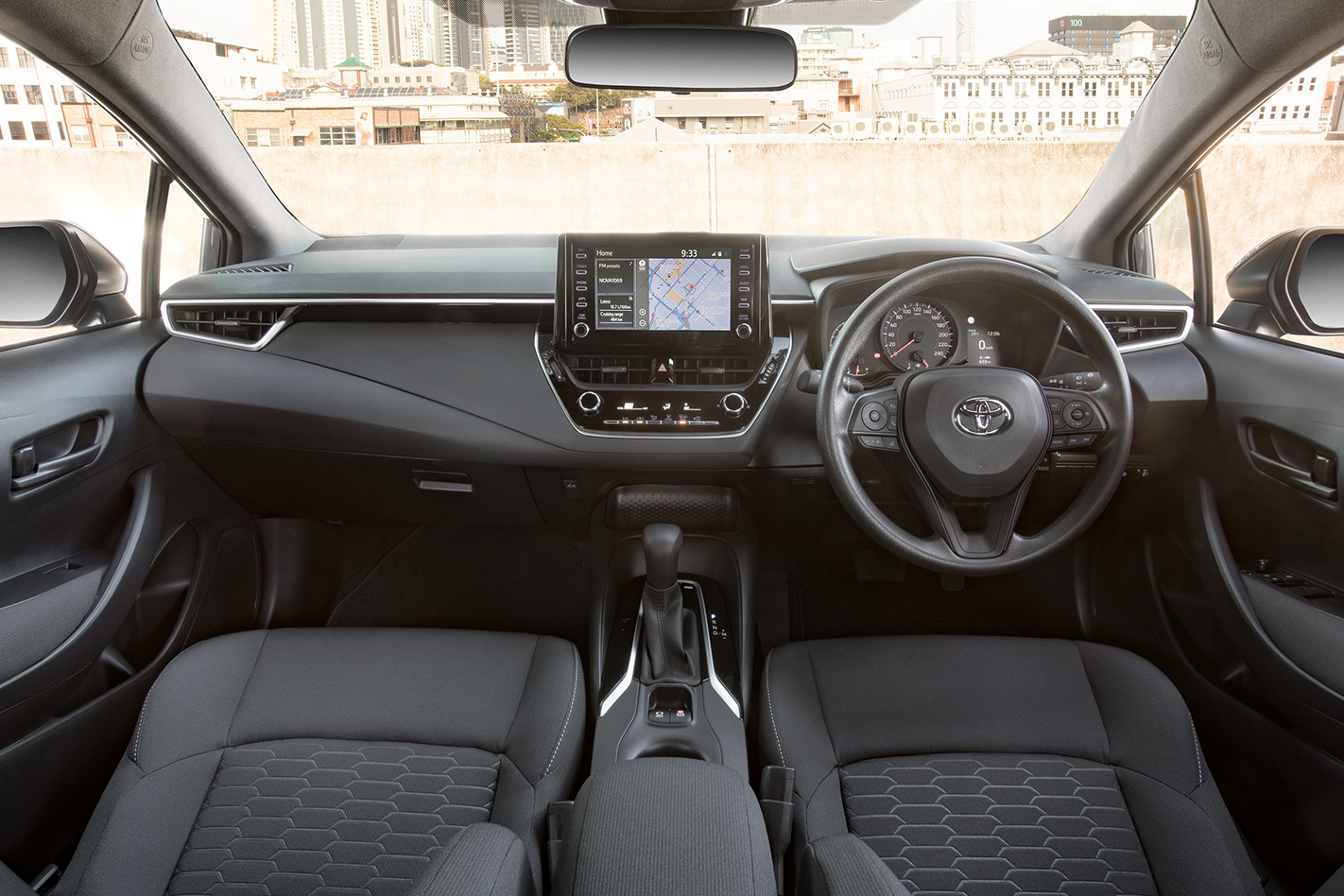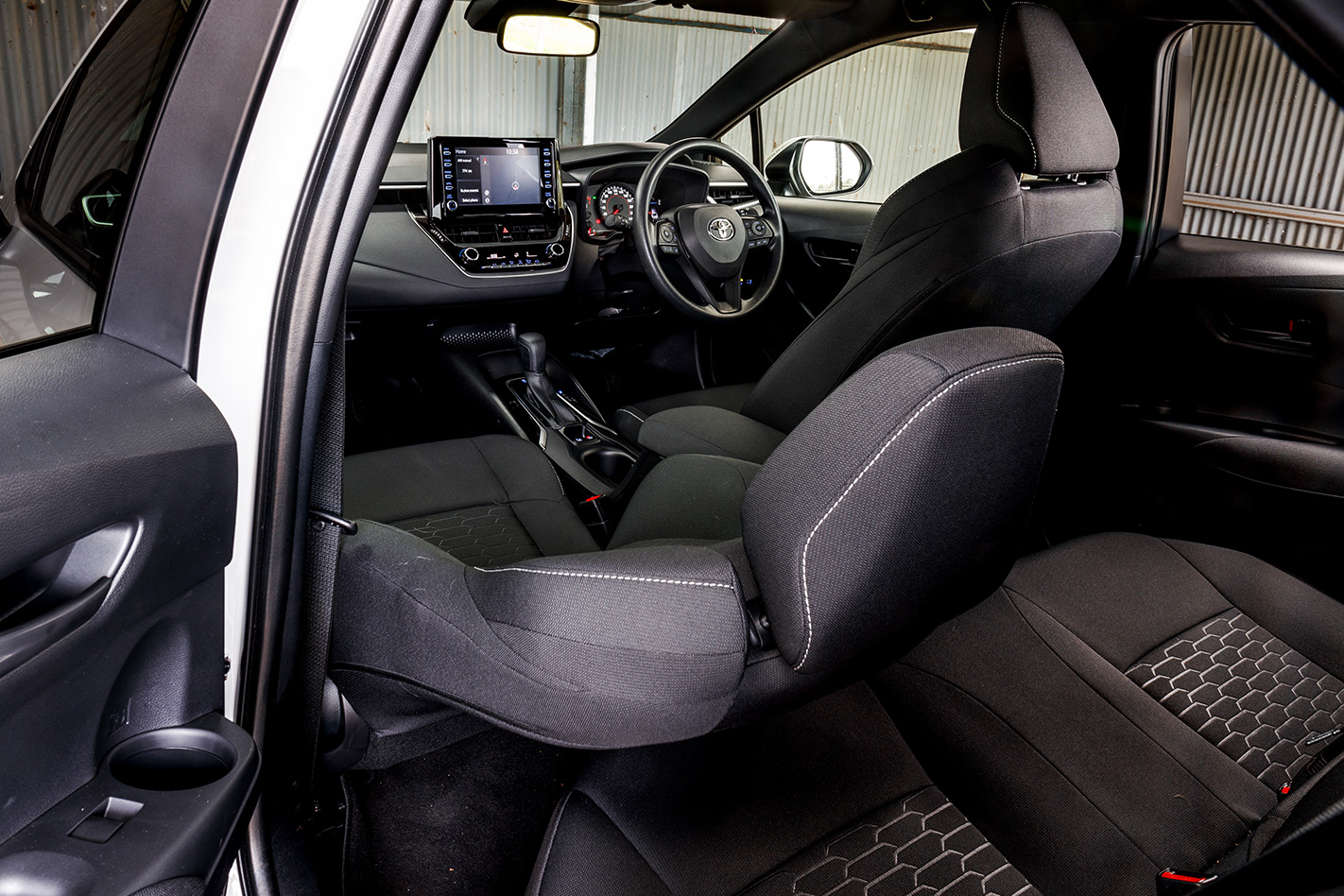
One of the strongest rivalries in the Australian vehicle market has been the fight for top-spot between the Toyota Corolla and Mazda 3. The Corolla has been the consistent winner in the passenger car stakes, but while the Mazda 3 is the perennial runner up it has widely been considered the better and more attractive car.
Enter the all-new 12th-generation Corolla, which has been designed to rid the world-beating hatch of its ‘beige’ but reliable image, with perky driving dynamics and class-leading standard active safety.
So how does it stack up against the Mazda 3, which has long been considered one of the benchmarks of its class?
We brought the automatic versions of the entry-level Corolla Ascent Sport and similarly priced Mazda 3 Touring together to find out.
HOW AFFORDABLE ARE THEY?
Priced at $24,370, the Corolla Ascent Sport is the cheapest automatic option in the new Corolla range, attracting a $1500 premium over the six-speed manual.

As well as a more convenient continual variable transmission (CVT), the Ascent Sport auto also gains three driving modes (Eco, Normal and Sport) adaptive cruise control that works at low and high speeds, and lane-keeping assist.
View the full pricing and features for the 2018 Toyota Corolla range here
The vehicle we tested was the Ascent Sport auto in Glacier White, which is the only paint option not to incur an additional cost – the other seven colours attract a $475 premium. Optional extras included satellite navigation, digital radio (DAB+) and rear privacy glass, which are bundled together as part of a $1042 package, which took the retail price of our Corolla to $25,412.
The Corolla’s highly efficient 2.0-litre petrol engine has a frugal official fuel consumption rating of 6.0-litres/100km when coupled with the automatic transmission. Our real-world testing showed 8.1L/100km with a mix of highway and inner-city driving.
The petrol Corolla requires a service every 12 months or 15,000km, which is about average. Each service between from 15,000km to 75,000km is capped at $175 with Toyota Service Advantage.
The Corolla is covered by Toyota’s three year/100,000km warranty.
The Mazda 3 Touring is the plushest of the 2.0-litre Mazda 3s, with retail pricing starting at $25,490 for the six-speed manual, with the six-speed auto attracting a $2000 premium. The sedan and hatch versions cost the same.
The Touring costs just $4000 more than the entry-level Neo Sport and $10,000 less than the range-topping SP25 Astina.

The 2.0-litre engine is reasonably frugal, with an official combined fuel consumption figure of 5.8L/100kms when coupled to the optional six-speed auto. Our real-world driving saw that figure rise to 8.5L/100km, though this involved quite a lot of city driving, mostly in Sport driving mode.
The Mazda 3 Touring requires servicing every 10,000kms or 12 months, whichever comes first, which is relatively frequent. Mazda charges $303 for the first and third service appointments and $331 for the second and fourth
WHAT FEATURES DO THEY HAVE?
The Corolla Ascent Sport Auto is the most advanced entry-level variant in its class, and comes with advanced safety features that were unheard of in small hatchbacks just a few years ago. These include adaptive cruise control, autonomous emergency braking with pedestrian and cyclist detection, lane keeping assist, and speed-sign recognition.
You also get a big 8.0-inch touchscreen with voice recognition, which clearly displays a reversing camera image with fixed guidelines. Infotainment includes AM/FM radio and connectivity with your mobile device via Bluetooth or USB for phone calls or music streaming. For an additional $1042 you can add satellite navigation with SUNA traffic information and digital radio DAB+.

Other features include cloth seats, and there’s an electric parking brake that frees up space on the centre console, LED headlights with auto high beam, LED tail-lights, LED daytime running lights, rear fog-lamps, and power-folding heated exterior mirrors.
The Ascent Sport rolls on 16-inch aluminium-alloy wheels and you get a full-sized spare alloy wheel.
The Mazda 3 Touring adds a few creature comforts over the Mazda 3 Maxx Sport, and the Corolla Ascent Sport for that matter, including leather upholstery, automatic folding mirrors and advanced keyless entry that lets you open the door and start the engine without having to take the key fob out of your bag or pocket.
That’s on top of a healthy equipment list that includes a 7.0-inch colour screen, AM/FM/Digital (DAB+) radio, and autonomous emergency braking that also works in reverse to help prevent parking bingles.

Other features include rear-parking sensors, cruise control, blind-spot monitoring, rear-cross traffic alert, dual-zone climate control, dusk-sensing headlights, LED fog-lamps, rain-sensing windscreen wipers, an electric park brake and 16-inch alloy wheels.
HOW PRACTICAL ARE THEY?
The 2018 Toyota Corolla and Mazda 3 are five-door hatchbacks that seat up to five people. The Mazda 3 is also available as a four-door sedan.

Measuring 4375mm long by 1709mm wide, and weighing in at 1340kg, the Corolla Ascent Sport auto is average sized for its class, however the boot space is very small, with a miniscule 217-litre capacity that’s 142 litres smaller than the previous model Corolla and 69-litres less than the Yaris.
The Mazda 3 is a little bigger, measuring 4.47m long by 1.79m wide, and weighing in at 1308kg, and while the boot space is bigger than the Corolla’s, it’s still a tight 308-litres, which is less than smaller cars such as the Kia Rio and Hyundai Accent. The Mazda 3 sedan’s boot holds a more sizable 408 litres.

HOW SAFE ARE THEY?
The new Toyota Corolla hatch was awarded a five-star ANCAP safety rating in August 2018 thanks in part to its active safety features, including autonomous emergency braking (AEB) with cyclist and pedestrian detection, and lane-keep assist.
It scored well for crash protection – 96 percent and 86 percent for adult and child occupant protection respectively – and is equipped with seven airbags (front, front side, full length curtain, and driver’s knee), ISOFIX child seat anchors in the rear seats, and seatbelt warnings.
The Mazda 3 also received a five-star ANCAP safety rating, in August 2016, thanks in part to its active safety features, including range-wide autonomous emergency braking. It scored well for crash protection, including 16 out of 16 for side impact. It has six airbags, and child-seat anchor points including two ISOFIX brackets for each outboard rear seat, and three top tethers.
The Touring spec brings additional active safety over and above the standard Mazda 3 kit, including blind-spot monitoring and rear-cross traffic alert that warns you of any cars approaching from the side while you reverse.
HOW COMFORTABLE ARE THEY?
The 12th-generation Corolla has a fresh and ergonomically sound cabin design. Build quality is hard to fault and the materials used also have a high quality feel.
That said, the Ascent Sport’s plastic steering wheel isn’t as pleasant as the leather wrapped tiller in higher-spec SX and ZR Corollas, or the Mazda 3 Touring, but the buttons are laid out intuitively, including the cruise control switchgear, which are mercifully no longer located on a separate stalk.

The cloth upholstery also feels durable and the front seats have deep cushions and great lower- and upper-back support.
The back seats are comfortable too, however leg and headroom is tight, with the shins of the average sized adult touching the front seats. A centre armrest has two cup holders, and there is also a handy cup holder on each of the rear-door armrests.
Rear storage is confined to a map pocket behind the front passenger seat and there are no air vents or USB and 12v sockets for rear-seat occupants.
The ride down back is pleasant though, thanks to the Corolla’s advanced multi-link rear suspension that handles lumpy rural roads in a composed manner.
The Mazda 3’s interior is showing its age, but still has an air of sophistication with soft-touch surfaces aplenty, clean design, a leather-clad steering wheel and intelligently-placed switches and gauges. The seats, trimmed with a mix of real and faux leather, offer good comfort. The driver’s seat has height and lumbar adjustment to help you settle into a good driving position.
The MZD infotainment system is easy to operate via a dial on the centre console. It lacks the added convenience of Apple CarPlay and Android Auto smartphone mirroring, however an upcoming update will allow that tech to be retrofitted next year.

The Mazda 3 loses marks in the back row, with its ascending window line obscuring side vision for younger occupants. Legroom is a little tight as well, with even average-sized adults finding their shins touching the front seats.
Second-row passengers also miss out on conveniences such as face-level air vents, and there are no USB or 12v charging sockets to keep devices charged up. It might be a niggling complaint, but those features are fast becoming common in newer cars in the segment. There are at least bottle holders in the doors and the fold-down centre armrest has two cup holders, though there’s only one map pocket on the passenger side.
Road noise can also be high despite Mazda attempting to improve sound suppression in a 2016 update, but the ride is comfortable even on rougher roads thanks to a settled ride that recovers quickly from big hits.
WHAT ARE THEY LIKE TO DRIVE?
The new Corolla was built with the driver in mind, and has been re-built from the ground up on a new longer, wider and stiffer chassis with a sophisticated new multi-link rear suspension.
The well-balanced chassis combines with nicely-weighted and direct-acting steering to make cornering surprisingly good fun. It handles bumpy roads great too, with the multilink suspension feeling like it’s cutting through road imperfections rather than merely rolling over them.

The highly-efficient 2.0-litre petrol engine is the most powerful engine for its size without a turbo and, coupled with the CVT automatic, is the pick of the Corolla’s powertrains over the 2.0-litre petrol manual and 1.8-litre hybrid CVT.
While CVT autos usually have a revvy but sluggish rubber-band feel, the 2.0-litre Corolla’s has a ‘launch gear’ that steps through the gears like a traditional automatic gearbox. This helps it take-off sharply from a standstill, while also offering responsive acceleration while on the move, such as when overtaking.
The Mazda 3 Touring’s 2.0-litre engine is a city slicker but has enough power for easy trips down the highway, with the six-speed automatic transmission working smoothly with throttle inputs.
It is, however, a little lethargic from a standing start and doesn’t really wake up until the tachometer hits about 4000rpm. A Sport drive mode introduced in 2016 makes the engine rev higher before shifting up to the next gear, though frequent use of that feature will see your fuel consumption head north.
The Mazda 3 is an enjoyable car to drive, with light but engaging steering that makes easy work of negotiating suburban streets and bendy country roads. Despite its age it remains one of the segment’s best when it comes to handling.

The ride feels soft but delivers enough body control for sharp cornering. This is helped by something that Mazda calls G-Vectoring Control, which subtly trims power when cornering to transfer load onto the front tyres and help them produce more cornering grip. Result: the car feels more planted while changing direction more fluidly, but you’ll barely notice that the electronics are giving you a helping hand.
OUR OPINION
The Corolla has youth on its side, and its generational leap over the Mazda 3 certainly gives it the edge in terms of styling, efficiency, performance, handling and technology.

It’s not a cakewalk though, because the five-year-old Mazda 3 has aged gracefully thanks to incremental improvements that have brought active safety and boosted driving dynamics. It’s an enjoyable car to drive, and the Touring’s leather upholstery and keyless entry/start give it a more premium feel over the Corolla Ascent Sport.
And, for all the Corolla’s gains, it isn’t quite as practical as the Mazda, with slightly tighter rear-seat and boot space.




